Home >
Mashonaland West >
Thomas Baines watercolours and sketches from the Natural History Museum (London) with the relevant text from The Northern Goldfields Diaries of Thomas Baines (1869-1872) edited by J.P.R. Wallis - Part 4
Thomas Baines watercolours and sketches from the Natural History Museum (London) with the relevant text from The Northern Goldfields Diaries of Thomas Baines (1869-1872) edited by J.P.R. Wallis - Part 4
Introduction
J.P.R. Wallis in his introduction to Volume 1 of the Northern Goldfield Diaries of Thomas Baines writes that they show Baines as: “one of those sober Englishmen that East Anglia breeds, quiet, competent, self-reliant and friendly, who enjoy doing things for the doing’s sake and are content to let the rest go by.”
The lectures in England by Professor Tennant on the 1867 diamond discoveries in the Orange river gravels and R.J. Mann on Karl Mauch’s gold discoveries at Tati and in Mashonaland aroused great interest in England, Australia and America and caused some adventurous spirits to sail for the Cape and Durban. A number of companies were formed to finance exploration expeditions, one of them being the South African Gold Fields Exploration Company, a subsidiary of the Natal Land and Colonization Company with whom they shared London offices, company secretary and many directors.
In 1868 Baines was offered the leadership of the company’s exploration expedition to Matabeleland and Mashonaland. First though he had to win the approval of his mother, a capable and sensible woman, who had to be persuaded that this was not just another quixotic scheme where he would sacrifice himself and his prospects in yet another wild-goose chase!
Initially the plan was for Baines, once he reached Africa, to give command of the party to Sir John Swinburne, the current chairman of the London and Limpopo Company, who was already in Africa and had won a concession from Mzilikazi the amaNdebele king to work the Tati goldfields, an area also claimed by Matjen, the current Bamangwato chief. Swinburne however lost credibility with the amaNdebele when he repeatedly lied to them and tried to organise a mining monopoly for himself with the aid of the Rev Thomas Morgan Thomas at Inyati mission.
The South African Gold Fields Exploration Company prospecting expedition
Baines companions included C.J. Nelson, a Swedish mineralogist and mining engineer, with good practical experience who in time understood the company were committed to making the greatest gain for the least expense and left its employ. Baines met him later working on the Tati claims.
Robert Jewell was appointed as secretary and photographer. William Watson, Baines’ cousin was recruited in Natal and spoke Zulu and was a blacksmith by trade. Both were somewhat immature and criticised Baines’ mapping efforts and his interest in natural history, but he bore their criticism with his usual good humour and their relationships were relaxed.
Baines’ diaries
Baines was very conscientious in keeping up his diaries. He made three or four carbon copies of his entries and sometimes one or more of the copies becomes blurred or missing where the carbon has slipped. Wallis states that that no existing collection of his diaries is complete and their ultimate destinations are not known. Probably the South African Gold Fields Exploration Company received a set; another was sent to his mother through the Royal Geographical Society (RGS) He may have sent a further set to the RGS, but Wallis states the RGS set is incomplete and the diary text used here was compiled by Wallis from several sources including the RGS, the Brenthurst Library and the National Archives of Zimbabwe.

Scan of Baines diary from the Brenthurst Library sent by Ian H. Mackay
Baines may have thought that at some time his diaries might serve as a source for a book because they are far more than just company reports and Oliver, the London company secretary, did have to make summary extracts for the directors from all the information Baines sent him.
His diary recording took place at night after busy days and when the camp was asleep by candle or fire light and clearly he took a quiet pleasure in setting down the day’s events on paper. During the day he carried around a cheap notebook and jotted down events as they happened in pencil. The words are always written in an easy and attractive style sometimes accompanied by little sketches of an insect or plant.
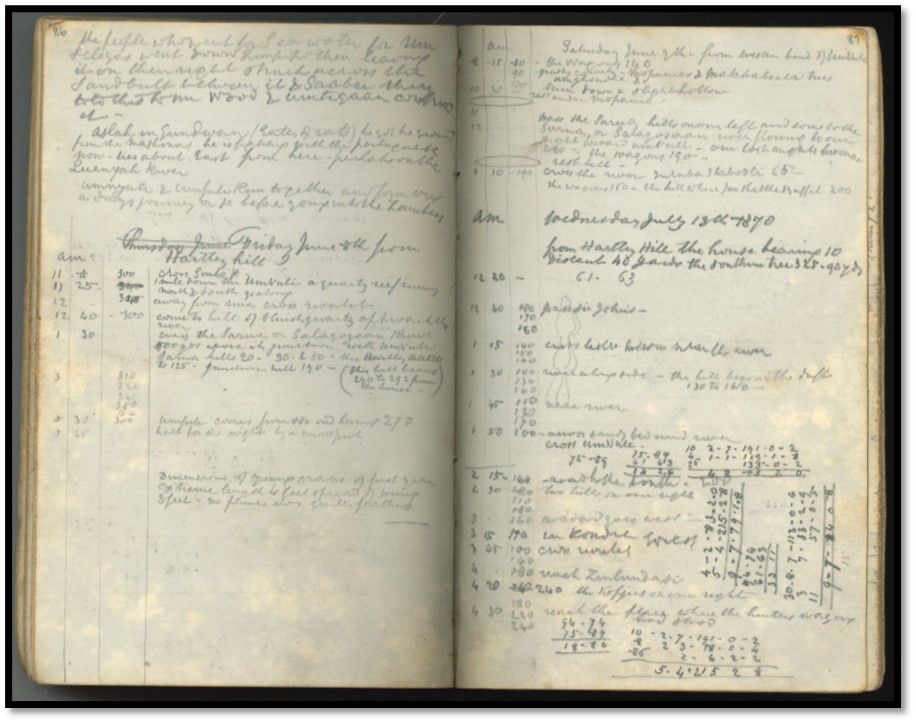
Scan of Baines diary from the Brenthurst Library sent by Ian H. Mackay – this entry written at Hartley Hill
His sketches and paintings are built up from subjects that interested him as they trekked with an initial quick rough and ready thumb-nail sketch. Although self-taught, Wallis writes: “yet he had that zest for and delight in art that knew nothing of refinements and sophistries. He had an instinct for composition and an honest delight in the beauties of colour, form and motion… A traveller, following ways at best imperfectly charted, when charted at all, he had to cultivate the swift retentive vision and memory that took in unconsciously and recorded infallibly the landmarks, the nature and lie of the country, with the position of the sun and stars. And, dependent upon his gun for most of his own and his followers sustenance, he had to know the ways of the wild game, their likely lairs, their physical characteristics and their habits. Nature, and not studio models and lay figures were what he copied.” Wallis concludes: “If in the kingdom of art there be not a place for Baines at his not infrequent best then so much the worse for the kingdom of art.”
Wallis concludes his writing has “the same masculine honesty, sincerity and enjoyment. He was catholic in his interests, shrewd and with a quick sense of humour and he kept an open mind. As he confessed: “I never like either to contradict or disbelieve any tale, however marvellous or incredible it may sound at first, but simply withhold my belief till I hear more.”
He describes Baines as a sunny optimist who delighted in hard work whether it was fixing the wagon wheel spokes, to making copper tacks for his canvas frames or to building a timber house at Hartley Hill and his cheery spirit found genuine satisfaction in meeting the challenge to invent, adapt or improvise. He was always ready to amuse playing Hamlet and Othello for a Christmas puppet show at Tati, singing rollicking rhymes or playing the accordion.
Natural History Museum (NHM) London Paintings and sketches
The high-quality images of Thomas Baines original watercolours and pencil sketches demonstrate his artistry and curiosity in the natural world around him. The collection comprises 155 sheets in 10 boxes. Their numbering 1 to 155 does not reflect their chronological sequence…it is only when you apply dates to the sheets that you realise that the numbering is not in date order. In the article I have used the NHM sketches at their appropriate date where they exist in the collection, but there are gaps and in some months there are few sketches and in others more sketches than I can use. Nevertheless the NHM collection is a marvellous cultural asset and I am hugely grateful that it is available for researchers and historians.
Editor of the diaries - John Peter Richard Wallis (1880 – 1957)
Much of the credit must go to Wallis who for 26 years was Professor of English Language and Literature at the University of Pretoria and on his retirement In 1943 was asked by the Southern Rhodesian government to put in order their historical archives in Salisbury. In May 1956 he was awarded an OBE "for public services to the Federation of Rhodesia and Nyasaland, especially in the editing of documents published by the Central African Archives." [i] The three volumes of diaries were published in 1946 only a year after Wallis edited The Matabele journals of Robert Moffat, 1829-1860 an amazing feat just after WWII when the diaries had to be compiled from the originals at London, Johannesburg and Salisbury. Wallis’ descriptions of Baines really capture “his cheery spirit found genuine satisfaction in meeting the challenge to invent, adapt or extemporize.”
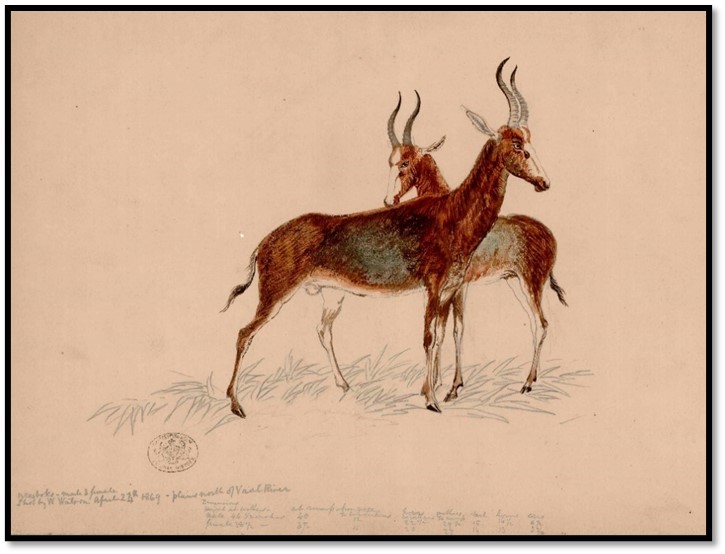
Natural History Museum (London) Baines Collection No. 145: Male and female Blesboks shot by W. Watson on the plains north of the Vaal river – 24 April 1869
Saturday 24 April 1869: “About half past six we had the waggon out and the country being level, we rode west til we crossed Loop Spruit and outspanned near the Losberg,[ii] not far from the house of Mynheer S. Pretorius at Elands Fontein.”
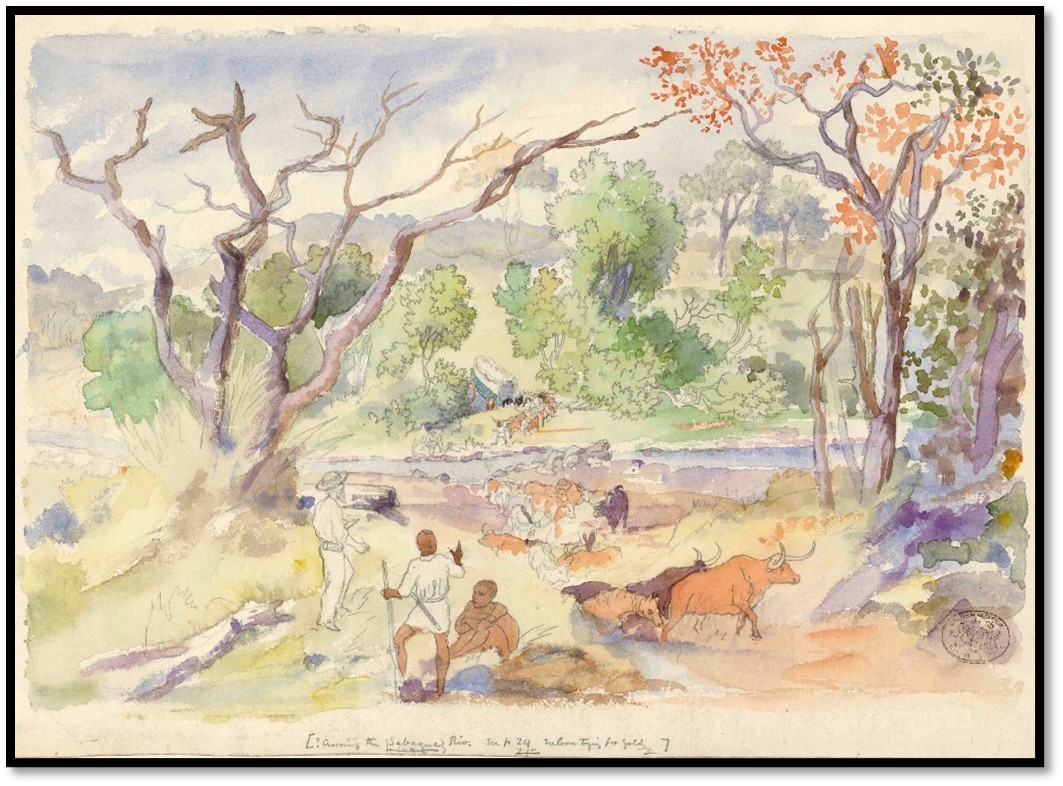
Natural History Museum (London) Baines Collection No. 16: Crossing the Sebaque (Sebakwe) river Nelson trying for gold – 16 August 1869
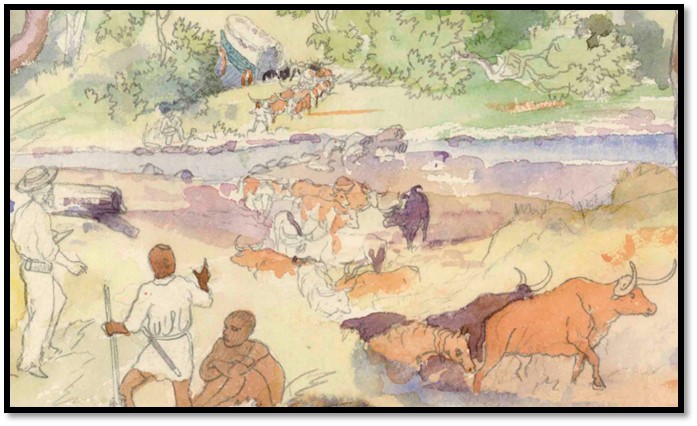
C.J. Nelson, the mineralogist to the South African Gold Fields Exploration Company can be seen in pencil panning the river for gold, Thomas Baines the expedition’s leader, is on the eastern bank with his rough notebook. Baines only makes a brief mention of the Sebakwe river here because that day they were soon busily engaged on a buffalo hunt.
Monday 16 August 1869: “Started at 7:30 and walked on rather more than two hours, learning the native names of trees and shrubs as I went, till the guides whistled and 200 – 300 yards in advance I saw half a dozen buffaloes, their jet black sides showing distinctly in the light, yellow grass. I crept on to the covert of a tree, reducing the distance to about 180 yards, and aimed at one. But my cap[iii] snapped, having been on all night and as I was putting on another I saw that other buffaloes appeared and four or five ranged themselves in a line sloping a little towards me. I fired at the farthest of these, trusting that if the bullet fell short it might hit a nearer one, as I believe, from the commotion, it really did. Thinking to get a closer shot, I crept on and seeing the Sebaque river running in the middle of its sandy bed, I plunged at once into the hollow out of sight of the herd, ran across the sand till I reached the stream, which was about middle deep and climbed the opposite rise where Inyassi,[iv] his eyes sparkling with excitement, pointed to the Buffaloes standing like huge oxen within 50 or 60 yards of me.”
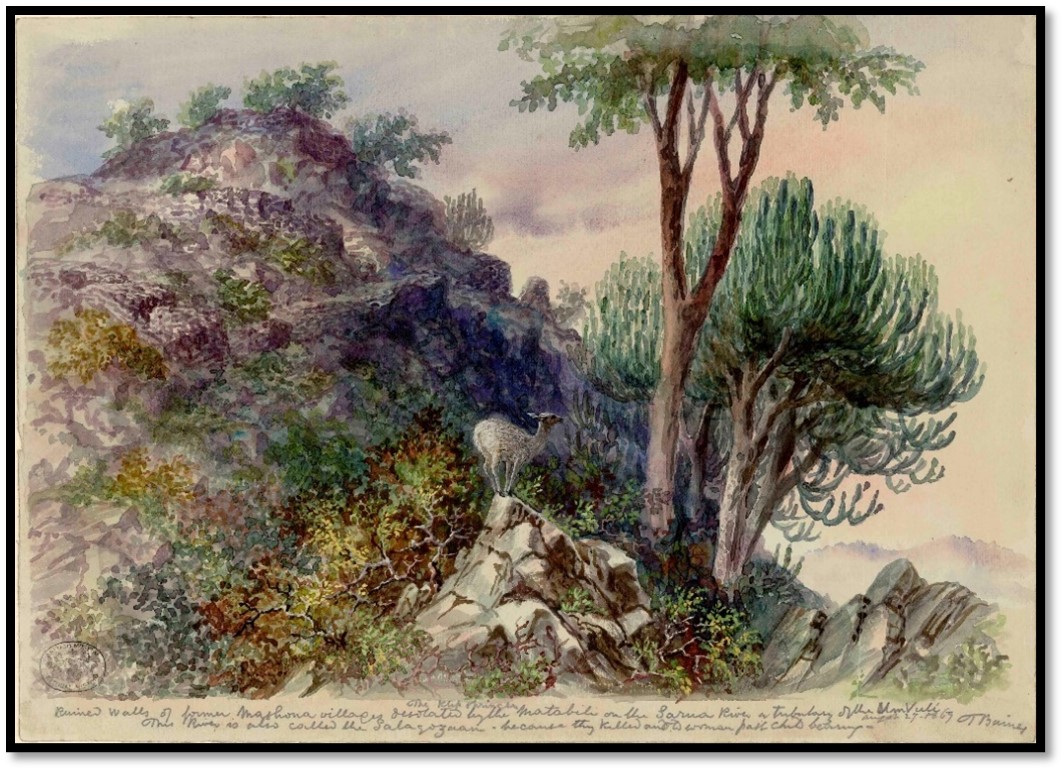
Natural History Museum (London) Baines Collection No. 17: Klipspringer (Oreotragus oreotragus) at the base of a kopje with the ruined walls of a former Mashona village on the Salagozaan or Sarua (Saruwe) river – 27 August 1869
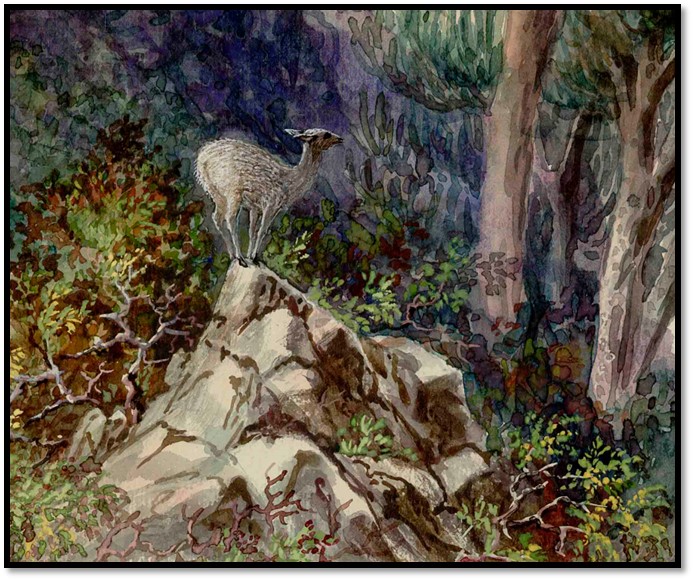
Friday 27 August 1869: “It was thus close upon 4 o'clock when I reached our halting-place of Tuesday night and turned off to the south-west to look for Sir John [Swinburne][v] In the wood not far distant I wounded another buck and on a neck among the granite ridges I saw a pretty little klipspringer or rock-leaping antelope, standing like a goat with all four feet close together on a stone.”
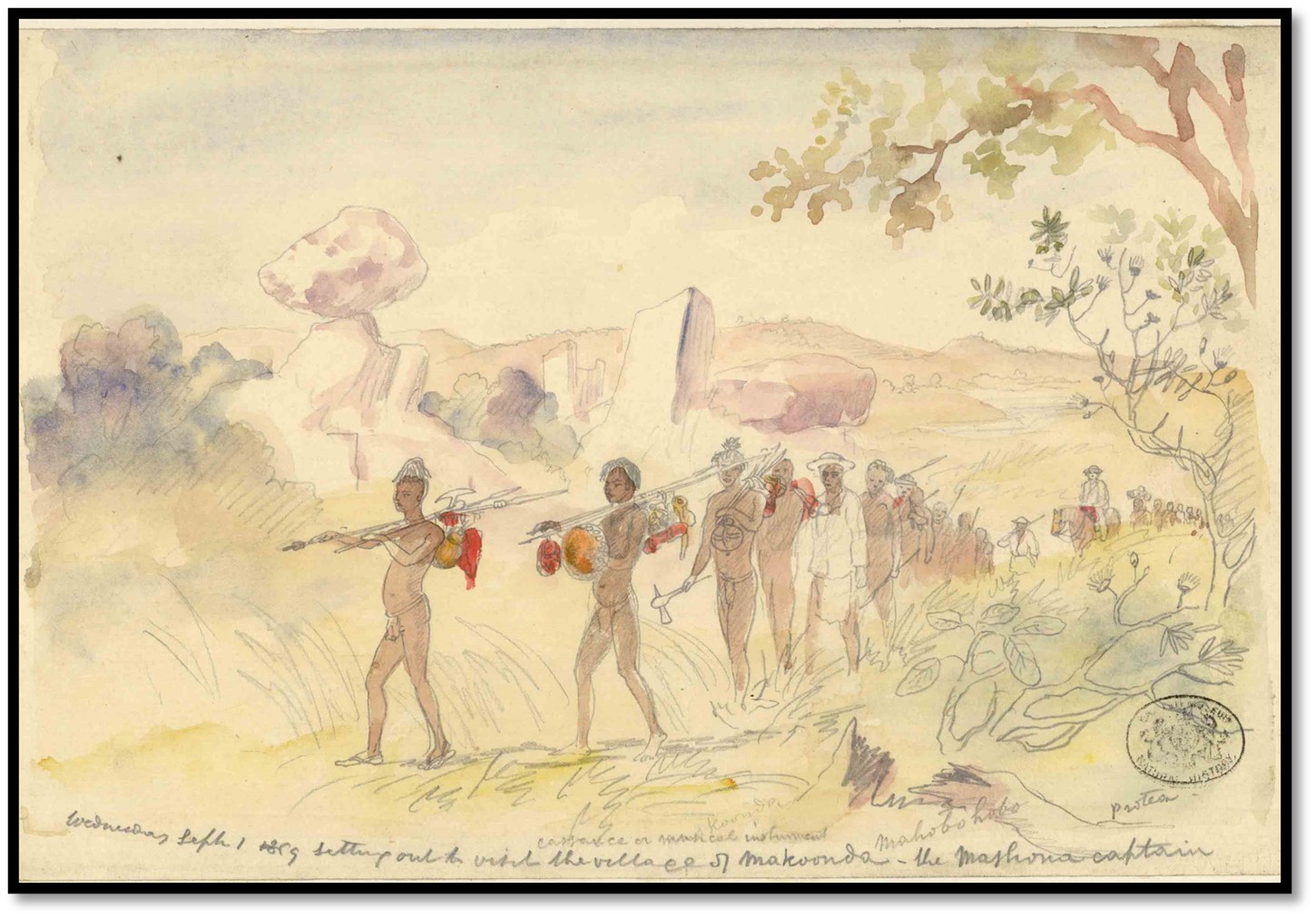
Natural History Museum (London) Baines Collection No. 18: Setting out to visit the village of Amakoonda – 1 September 1869
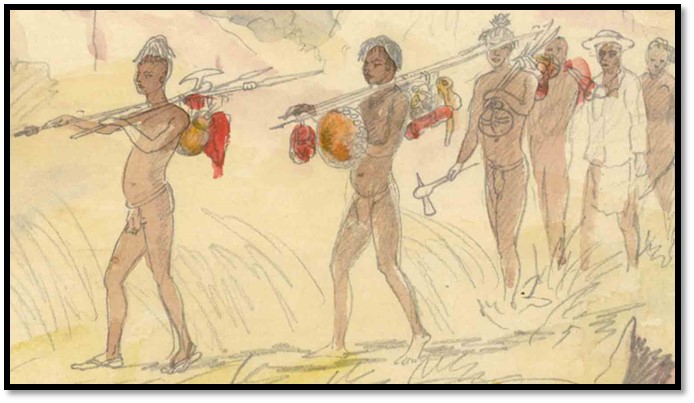
Wednesday 1 September 1869: “At 3 o'clock I saddled up and attended by my two Matabele, Inyassi and Siloquaine, accompanied Amakoonda[vi] and his ten or fifteen Mashonas towards the declining sun, every man of them bearing, besides his axe and spears, a junk of buffalo meat or entrails, calabashes for water or native corn in bundles. And one or two played as they went on the cassance[vii] or Zambesian keyboard, an arrangement of iron keys on a piece of light wood, the size of a quarto volume. This is held in both hands a little lower than a reader would hold a book and the keys are tinkled with the thumbs.”
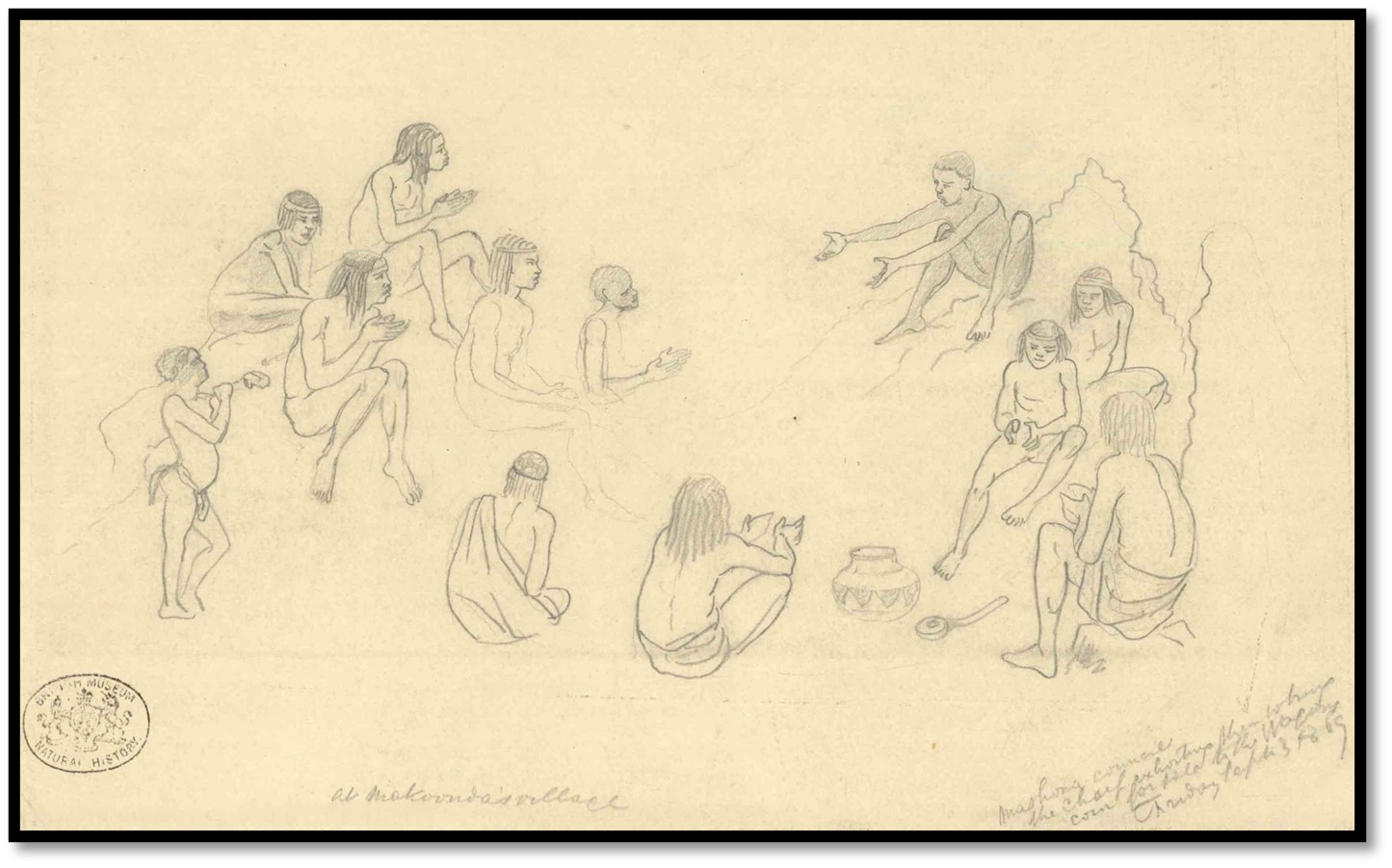
Natural History Museum (London) Baines Collection No. 21: At Amakoonda’s village a Mashona council where the chief is persuading the people to bring corn for barter at the expedition wagons – 3 September 1869
Friday 3 September 1869: “The headmen was sitting on a little rocky hill under the shade of a few trees and when I joined them a bag of dried locusts was offered me. I have very few prejudices and can enjoy a dish of nice fat white ants but I found the locusts were dry, husky and tasteless and though I ate them in default of something better, I cannot say that I should like to live long on such a diet. In due time however, a dish of Indian corn meal, which makes us somewhat firmer paste than the millet and a basket of dried locusts was brought me and handing the latter to my attendants, I ate as much as I required of the first. The guides in the meantime had been explaining the object of our visit. i.e. to invite them to bring corn, rice, groundnuts or any other produce of their fields for sale to our waggons.”
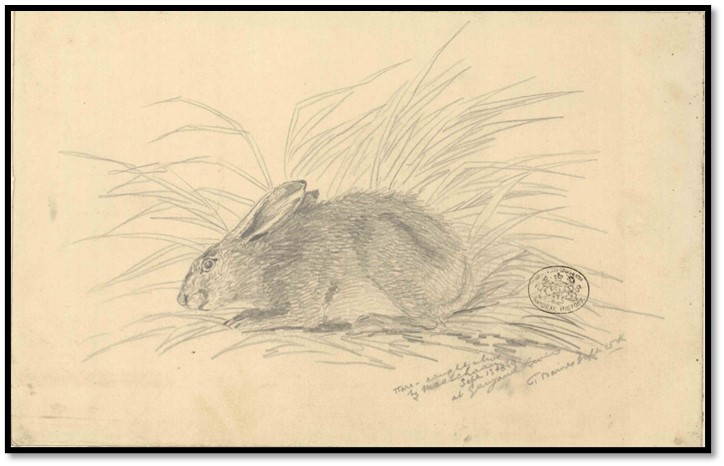
Natural History Museum (London) Baines Collection No. 96: Hare caught alive by Matchaan at the Ganyana river – 13 Sept 1869
Monday 13 September 1869: “I finished a picture of the giraffe hunt and presented it to Mr Hartley as an acknowledgement of his kindness to the expedition. He invited me to go with him on his last elephant hunt tomorrow and Mr Maloney and William [Watson] pressed me hard, as it would be the last opportunity I should have of seeing such a subject for a picture. But very much to my regret I was obliged to decline. A man cannot serve Art and Mammon. Indeed, the greatest, I might say the only hardship of the journey, at least to me, is that of being debarred from the use of my pencil, which not only would not interfere with but would promote the interests of the expedition.”
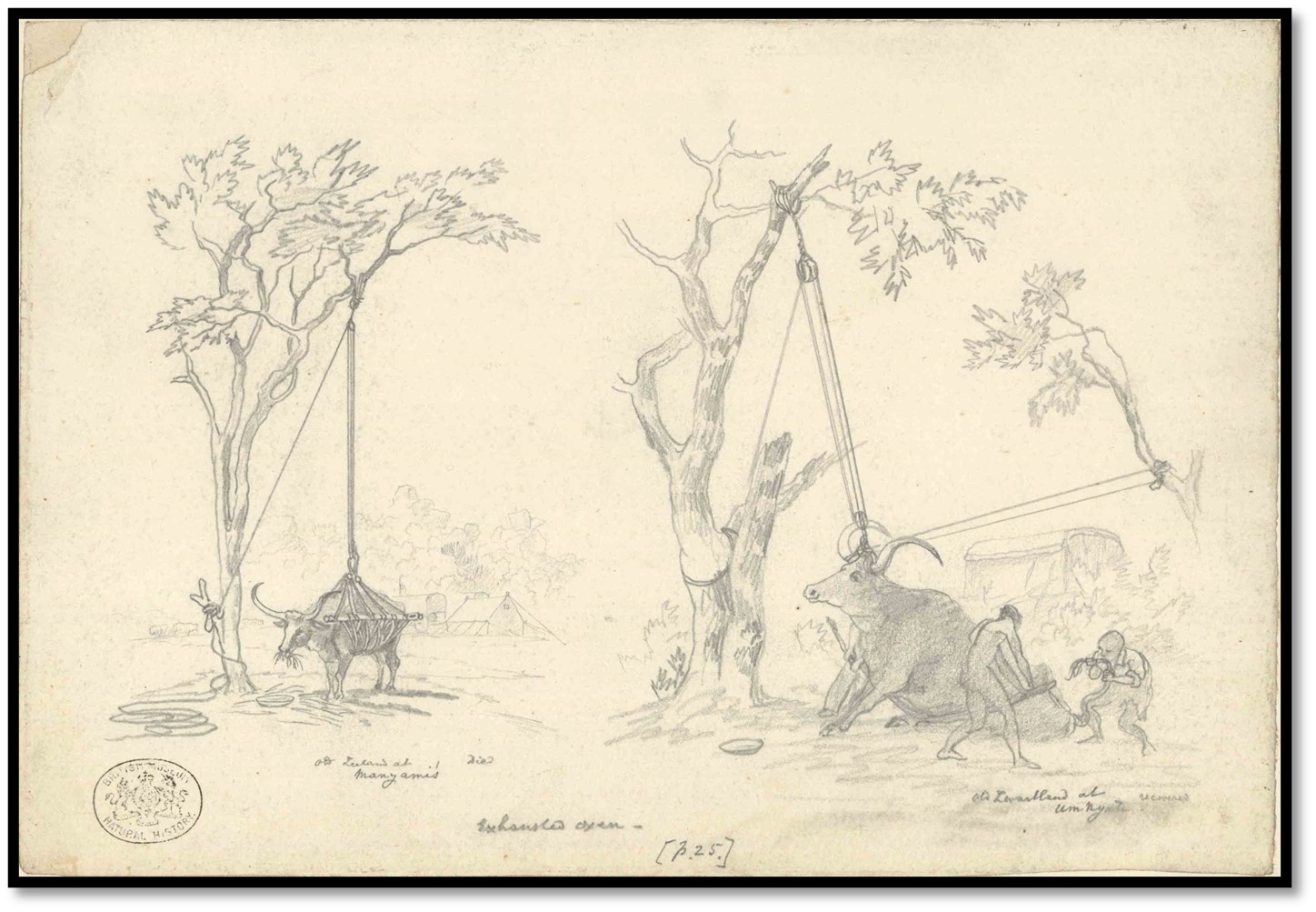
Natural History Museum (London) Baines Collection No. 29: Exhausted oxen (Left) Old Zeeland at Manyame’s kraal who dies and (Right) Old Zwartland at Umnyati (Nyati) mission who recovered – 10 October 1869
Sunday, 4 July 1869: “ We lifted the old ox [Old Zeeland] and came to the conclusion that it would be much better to shoot him tomorrow, as he is utterly unable to rise of himself and we cannot expect Manyame to take the trouble of lifting him or bringing him food and water. Our people will thus get a full feed of flesh before we start and we shall have some, however poor it may be, to take with us.”
Thursday 7 October 1869: “Old Zwartland cannot rise and I have not yet succeeded in lifting him, for even with the assistance of the tackle,[viii] Inyassi, Matchaan and I have not weight enough. I have sent for water and grass and must try again when the sun has warmed him.”
Sunday 10 October 1869: “Old Zwartland was down again and I had to take all the Matabele – 3 in number – to set him on his legs again”[ix]
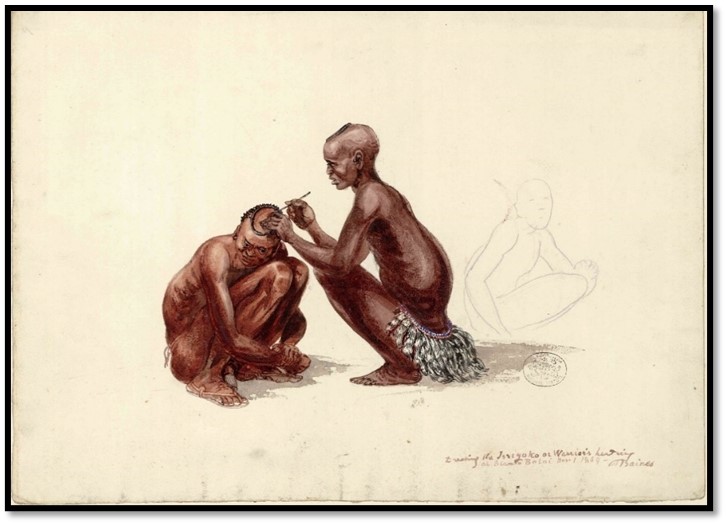
Natural History Museum (London) Baines Collection No. 69: Dressing the issiyoko or warrior’s head ring – 1 November 1869
Monday 1 November 1869: “Nobengulu [Lobengula] did not fail to remind me of my promise and I asked him to let me take his likeness. But to this he would not consent and as I thought it best to let him get over his fears gradually., I did not press him but drew a man with shield and spear and when this had attracted sufficient attention, I sketched three or four of the girls who clustered around. And as Nobengulu seemed hardly to comprehend the possibility of my drawing objects not actually before me at the time, I desired him to name the animal he would like to see and placed before him an elephant and next a giraffe, adding at his request men and horses engaged in the chase and completed his gratification by presenting him with the pictures, which he first stuck up for an hour in front of his hut and then carefully stowed away in his gun-case. He said that he had always thought pictures were made by some incomprehensible process and by people living far away and of so different an order that he never thought to meet any of them. And I was glad to hear him make this remark, for it showed that his mind was at least open to new impressions and I rather hoped to cultivate his friendship through the medium of art. I told Watson to explain to him that the wish to possess a portrait of a person was a mark of friendship and that Mr. Sykes and Thomas had asked me to take their children, just because they loved them and wished to look on their pictured features when the dear ones might perhaps be absent...
…In the afternoon I reached Slambo Boloi[x] where with some trouble I bought a goat and the people, as before, allowed us to sleep outside, the headman however, bringing a small present of curdled milk or amazi.”
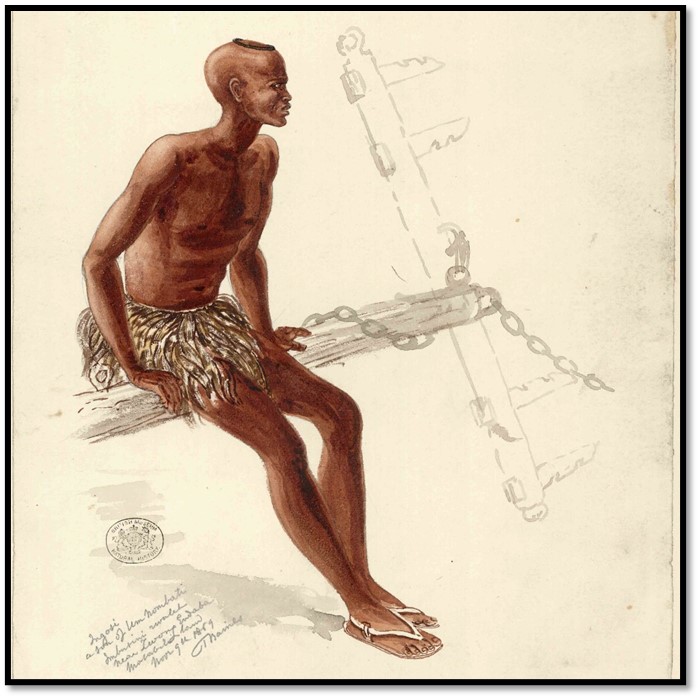
Natural History Museum (London) Baines Collection No. 72: Ingosi, a son of Umnombata (Ncumbata) at Umbusini rivulet near Zwangendaba – 9 November 1869
Tuesday 9 November 1869: “Almost the whole of the day was occupied in ‘playing’ a succession of troublesome visitors who all demanded ‘toosah’[xi] and quite ignored the proverb ‘beggars should not be choosers.’ Our former guide, Bulana, was exceedingly friendly but could not understand why I would not let them walk right into our waggon and sit upon my papers or instruments. Neither could he believe that my stores of bread, coffee, sugar, or barter goods could be, as they now are, nearly exhausted. He particularly wished me to give him a shirt and told me Mr Jewell had said I was to give him a hat and jacket. I suppose the truth is that he had bothered Jewell for these things and had been told to ask me, which, I explained to him, did not by any means oblige me to accede to his demand. None of the people had goats for sale, but one man promised to bring one as we passed his place, some miles onward.
After I was relieved of this clamorous throng I asked Ingosi, a son of Umnombata [Ncumbata] to sit for his likeness and after some hesitation, he did so. And I made a rapid sketch, tolerably like him considering his restlessness and the few minutes he gave me.”
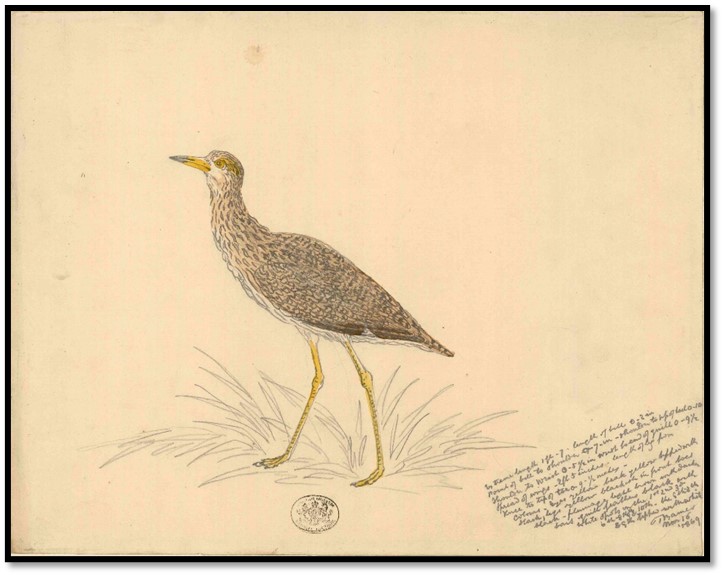
Natural History Museum (London) Baines Collection No. 149: The red-crested korhaan or red-crested bustard (Lophotis ruficrista) - 16 November 1869
Tuesday 16 November 1869: “Rain at first heavy but clearing off towards the afternoon. Watson shot korhaan of which I made a sketch and took the following measurements. Extreme length 1 foot 7 inches, length of bill 2 inches, point of bill to shoulder 7 inches, Shoulder to tip of tail 10 inches, length from point of bill to tip of tail 1 foot 5 inches, shoulder to wrist 5½ inches, wrist to end of quill 9½ inches, spread of wing 5 inches, length from knee to tip of toe 9½ inches.
Colours: eyes yellow, beak yellow tipped with black, legs yellow, blackish in front, toes black, plumage light brown with darker bars, quill feathers black with white spots on 1st, 2nd, 3rd, 6th, 8th, 9th and 10th; the 6th, 8th and 9th tipped with white. Tail extends 2 inches beyond the wings, brown barred above, black underneath, tipped with white. Vent feathers rich light brown.
At night the frogs begin their concerts for the season, more powerful than harmonious; hyenas and jackals and of course, the dogs taking their accustomed parts.”
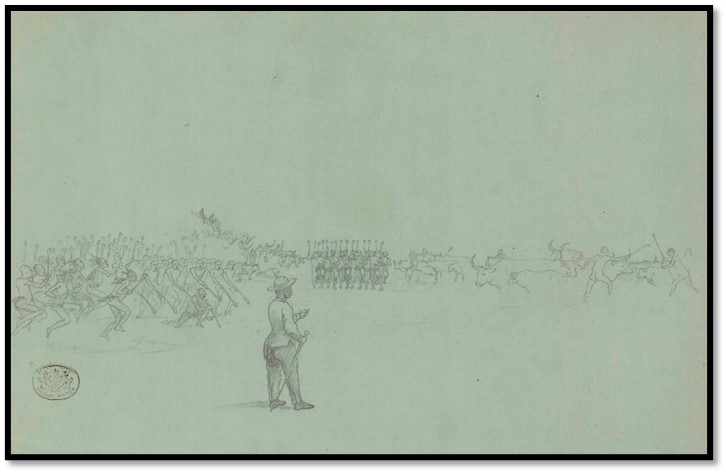
Natural History Museum (London) Baines Collection No. 61: Lobengula’s first act of sovereignty – 24 January 1870
Baines missed the coronation of Lobengula as king of the Matabele. John Lee was summoned by Umnombata (Ncumbata) on 21 January 1870 to Inthlathlangela to witness the event that took place on the 24 January and Lee returned to his farm at Mangwe and had breakfast with Baines, Robert Jewell and William Watson,[xii] Eduard Mohr,[xiii] Dr Coverley,[xiv] Henry Hartley and Sam Edwards.[xv]
Thursday 27 January 1870: “Mr Lee came over and took breakfast with us. He says he is glad I was not there and also sorry that I was absent… on Monday the 24th the destiny of Matabeleland was definitely, and I believe I may say, satisfactorily settled, Nobengula [Lobengula] being then declared the king and the successor of his father, Moselekatze [Mzilikazi] The warriors of the country, probably more than 9,000 in number, wearing their towering head-dresses of Sable ostrich plumes and ample capes of the same and bearing shields of the colours proper to their respective regiments, had assembled to join the dancers in honour of Nobengulu and this was the site Mr. Lee felt sorry I had missed…
…On Monday Nobengula performed his first act of sovereignty by superintending the slaughtering of the cattle brought as offerings to him. A small troop would be brought up by each tribe and from these six, eight, ten or a dozen were selected. The black ones were killed first, then the speckled and afterwards those of various colours. The first lot were stabbed as an offering to the manes of his father, the next to the Molimo [Mlimo] or Great Spirit and then others for various causes, an appropriate speech being made at each act of sacrifice. Umkaitjo, the fighting general and a very deserving sort of man came in for an unfortunate contretemps. Some of the cattle selected from his troop did not fall at the first fall of the assegai but escaped wounded and when after a general chase they were brought back, a volunteer who took on himself the office of stabber, killed many more than double the number before he could restrain himself…
The kraal was at length heaped with dead bodies which, during the night and the next day were skinned and cut up and the flesh cooked to be distributed by the king among his newly acquired subjects.”
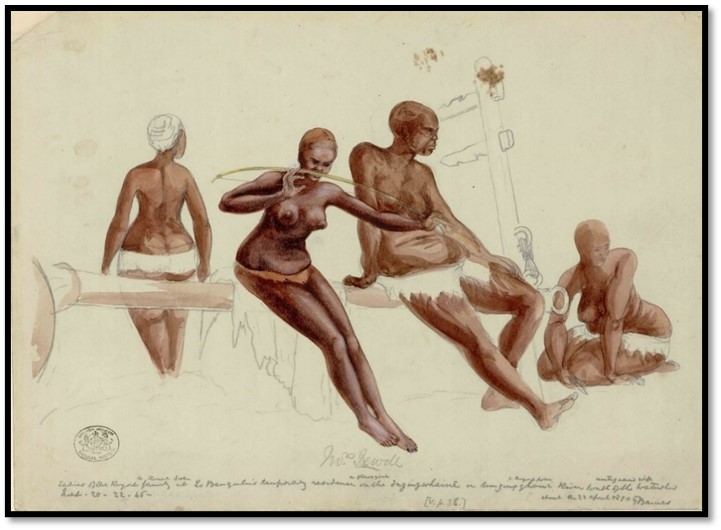
Natural History Museum (London) Baines Collection No 82: Ladies of the Royal family at Nobengulu’s temporary residence Inzingwhaine [Umzingwane] river (Left to Right) Royal sister, slave girl, Royal sister, Umtigan’s wife – 25 April 1870
Monday 25 April 1870: “The royal ladies exhausted all the blandishments of which female art is capable and I gave one a white grass-cloth coat, a little frayed at the wrists, with needle and thread to mend it; to another, Umtigan’s wife, I gave a blue striped shirt and other ladies, married or single, extorted similar garments from Jewell and it was not a little ludicrous to see the maternity and virginity of Matabeleland running about in its shirt or jacket, begging skirts or less mentionable garments for their nether limbs. The king sent for us to eat our farewell meal of good roast meat, without adjuncts of any kind. He said his heart was sore and he would feel lonely to lose all his white friends at once. I reminded him that Hartley was coming, but he said Hartley would go after elephants and would not stay with him.”
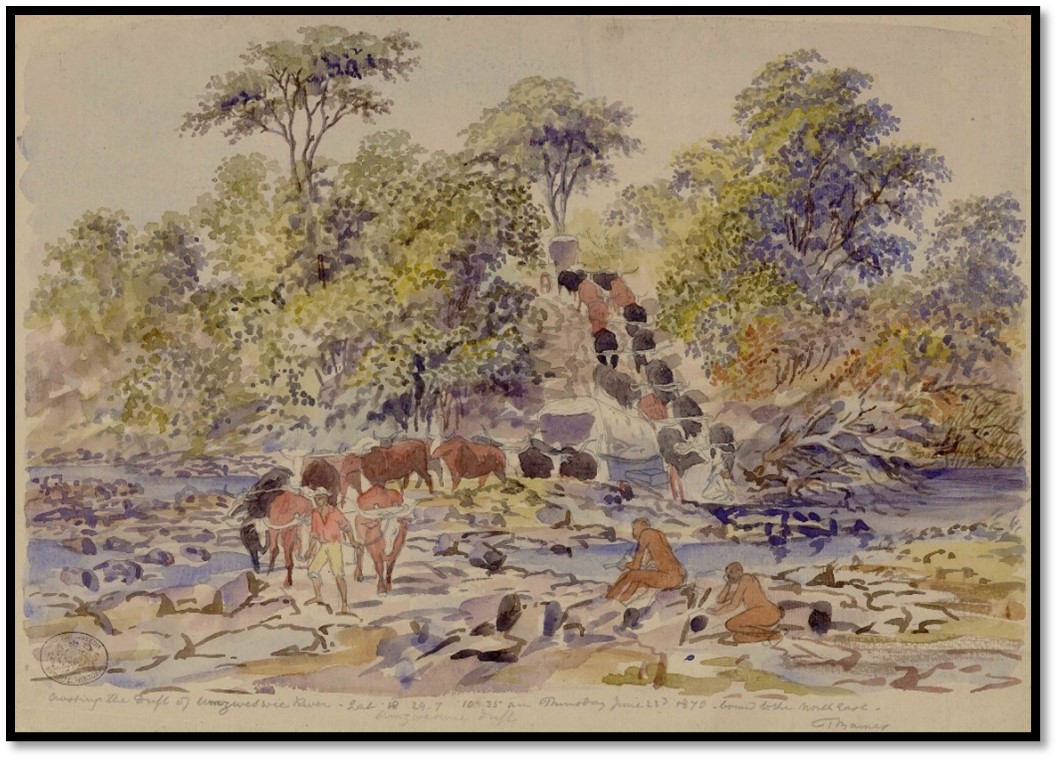
Natural History Museum (London) Baines Collection No. 39: Crossing the Umgweswie [Umsweswe] river drift - 22 June 1870
Wednesday 22 June 1870: “Reached Umgweswie rippling in two channels over broken rocks, while large quiet pools above and below reflected the dark green overhanging foliage. Buffaloes had been recently at the drift. Paopisa trees,[xvi] with their great polony-shaped inedible fruit, were near the banks and aiming at the long cord-like stem, I severed it with a bullet and brought the fruit heavily to the ground.”
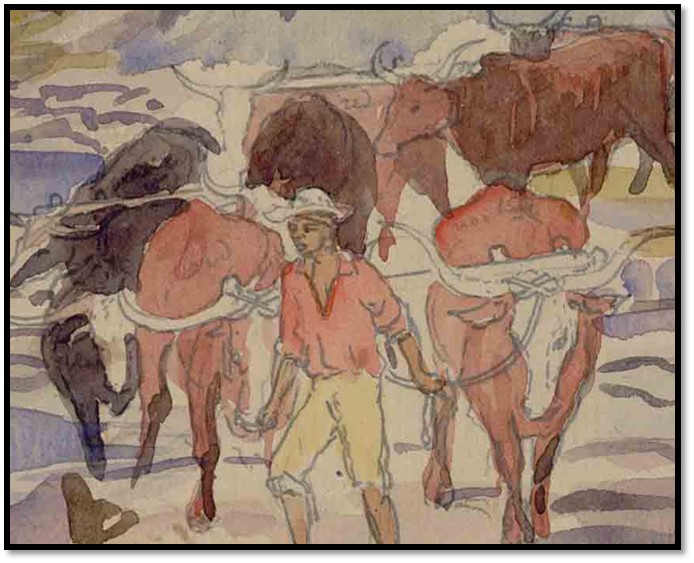
Thursday 23 June 1870: “After breakfast I marked the latitude on a fine Paopisa or Mosuawe tree under which we had slept and Jewell[xvii] took his camera across to a place we had previously marked. The leading waggon was launched down the steep incline and halted on the first channel, the oxen just stretching across the second, below where the water rippled over the rough stones. I had just settled down to get a sketch, but being within range of the camera, I had to sit still during the five minutes of exposure required and make a start to get ahead of the waggons as soon as they were again in motion. However, I have one advantage over the photographer, i.e. that I can finish my picture at another time.”
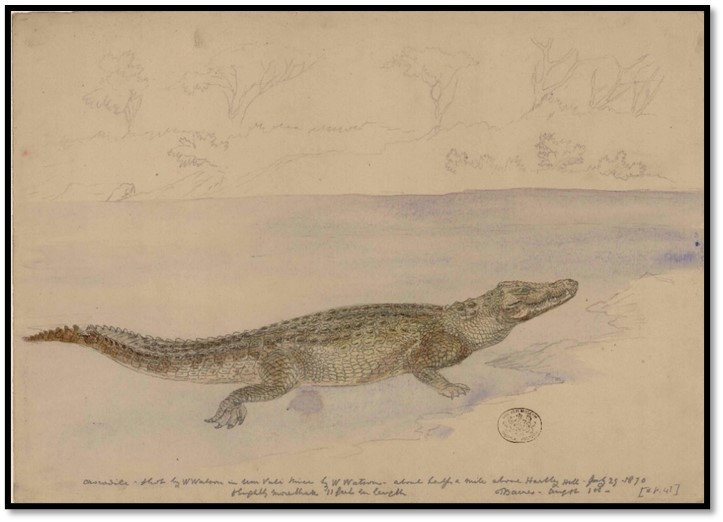
Natural History Museum (London) Baines Collection No. 151: Crocodile shot by Watson in the Umvuli [Umfuli / Mupfure] river about half a mile above Hartley Hill, slightly more than 11 feet in length – 29 July 1870
Saturday 30 July 1870: “…Watson has cut milk-wood trees into lengths and has split enough for a whole set of spokes[xviii] and other parts of a wagon-stell, has shot a waterbuck, a klipspringer and an alligator about 15 feet long, the last of which lies in the river…”
Sunday 31 July 1870: “…The brothers Jennings came over and spent the greater part of the day with us, after which we went to look at Watson’s alligator, lying on a sandbank at about 80 or 90 yards distance and apparently not far from the other shore.”
Monday 1 August 1870: “…Various plans were discussed for getting the alligator ashore. Watson wanted to take three or four of the assegais we have bought from the Mashonas as specimens, bend them into grappling irons and heave them at the carcase - a herculean feet indeed, even if our line were long enough to reach him. I borrowed two of Jewell’s copper boxes - my own not being watertight - and lashed two poles to the handles of each and two more under the bottoms, so as to connect them at a distance of about 10 feet from each other…At length I got the boxes carried to the river and seating myself on the lower poles, up to my breast in water thus.
I paddled my slow canoe, til Jewell shouted that the line I took with me had run out to the end and I told him to let it go and cross by the drift about a mile down to meet me at the other side, but first to wait till I reached the shore and fire, if necessary, at anything that might endanger my safety. The tide and weight of the line had drifted me far below the alligator, but I pedalled up in the slack water on the other side and sat on my raft till Inyassi and the men came round, for it would have been cold work to stand ashore shivering in wet clothes and a keen breeze. I pushed off again and found that I could just stand where the alligator lay. I put a running bowline knot round his fore-flipper and the men hauled him to shore and when I joined them and rolled him into a shallow water, his head, which had hung down as he lay on his back on the sandbank, now stood perked up with a life-like air of surprise or watchfulness...I put on a dry shirt and trousers and made a careful sketch, while Jewell gathered some fruit of the strychnine plant[xix] and, after we had eaten the pulp round the seeds, fitted up half a shell with a mast and paper sails and sent his ship gallantly sailing down the Umvuli [Umfuli / Mupfure]”

Baines ‘slow canoe’ to retrieve the crocodile carcase from the Umvuli (Umfuli / Mupfure)
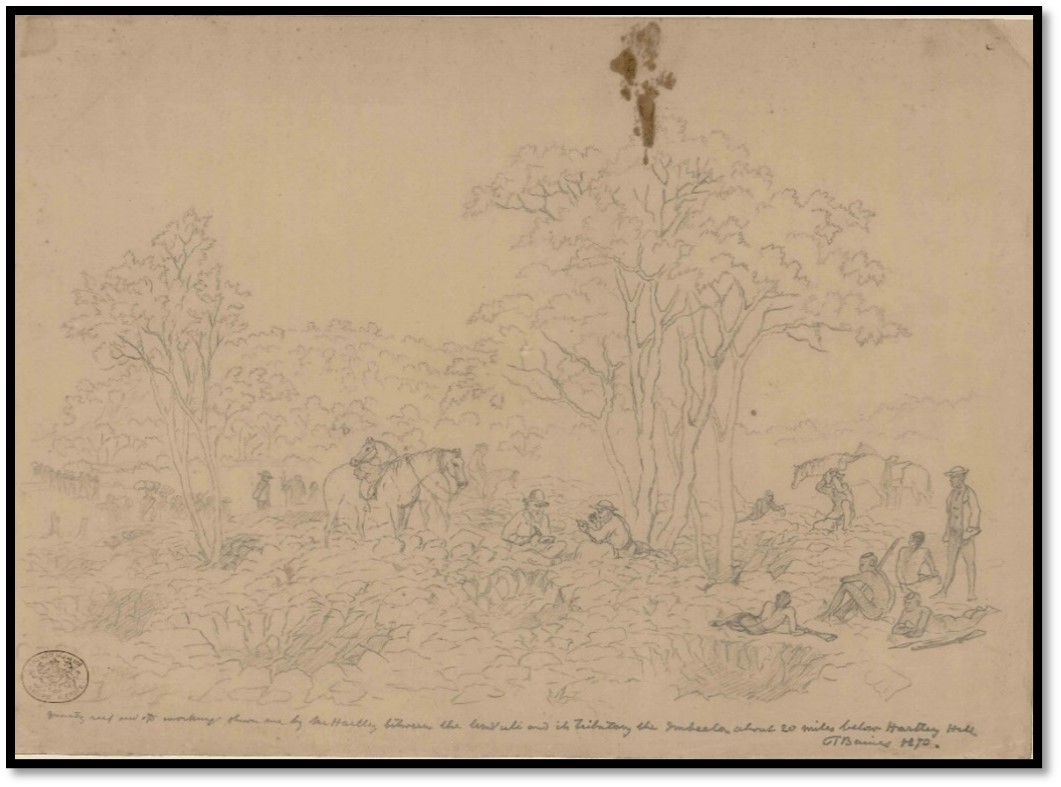
Natural History Museum (London) Baines Collection No. 44: Quartz reef and old Mashona workings shown me by Mr Hartley between the Umvuli [Umfuli / Mupfure] and its tributary the Imbeela [possibly the present-day Suri-Suri) about 20 miles below Hartley Hill – 6 September 1870
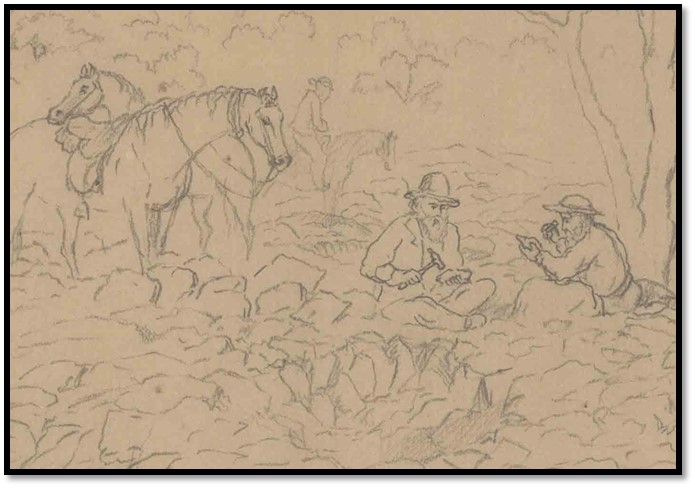
Henry Hartley with hammer, Baines examining quartz with a magnifying glass, Thomas Maloney on horseback
Tuesday 6 September 1870: “Mr Hartley,[xx] [Thomas] Molony [Maloney][xxi] and I started a little after seven, taking the north road across the Sarua [Saruwe] river, beyond which we turned out to the north-west…We crossed a ridge of quartz covered with shallow excavations stretching considerably to the eastward and after a short halt, just sufficient to satisfy ourselves that the reef was extensive and the quartz good looking, we passed onto another collection of diggings a little more north-west. Here we halted and broke some stones, but we could only take small pieces of the surface refuse and, though it looked very good, we did not find any gold.
We went on as far as we dared and having found water, chose a clump of trees under which to make our bivouac. Some of the natives found a tsetse, but as the evening was already closing in there was no occasion to fear for the next twelve hours. Proteas were growing not far from us and I myself could hardly realise the idea of danger from the tsetse in their vicinity. Nevertheless, we were on the ‘border of the fly’ if not actually within it.”
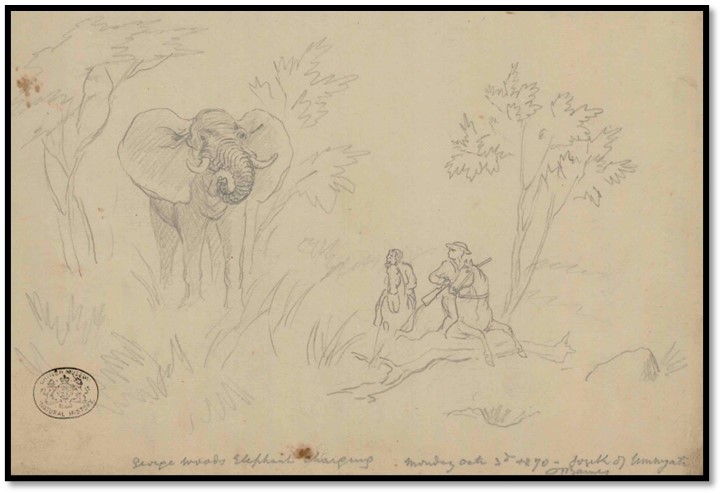
Natural History Museum (London) Baines Collection No. 104: George Wood elephant charging – 3 October 1870
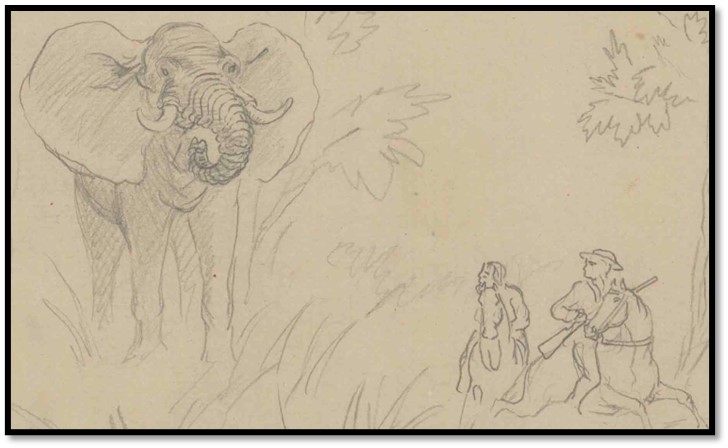
Monday 3 October 1870: “Wood[xxii] asked me to follow the other [elephant] and keep him in sight and as I rode up, I saw that he was at a stand. He started once, but I overtook him and pulled in just such a distance as not to put him to flight. I drew my little notebook and pencil and had just got the outline of his head and back when I heard the shot that settled the other and Wood called to me for direction. ‘Here he is’ said I, ‘Come on!’ and again we were in full chase. The elephant had recovered breath and led us on. We sheared out to the left, passed him, and pulled in for a shot. He was not, however, inclined to accommodate us. Wood shouted and he answered the call by turning round towards us with expanded ears, elevated head, sharp twinkling eyes and trunk held at the ready. I thought I had never seen anything so grand as he began to bear down upon us like a ship with stunsails set on both sides and Wood had to call me twice before I could cease admiring him. Wood led off and I followed close, for as I had forgotten to bring my spurs I felt that my only chance of getting speed out of my horse lay in keeping him right up to the tale of a leader. Our pursuer screamed with rage and we galloped on for 150 or 200 yards, swerving now and then to see whether we might not halt.”
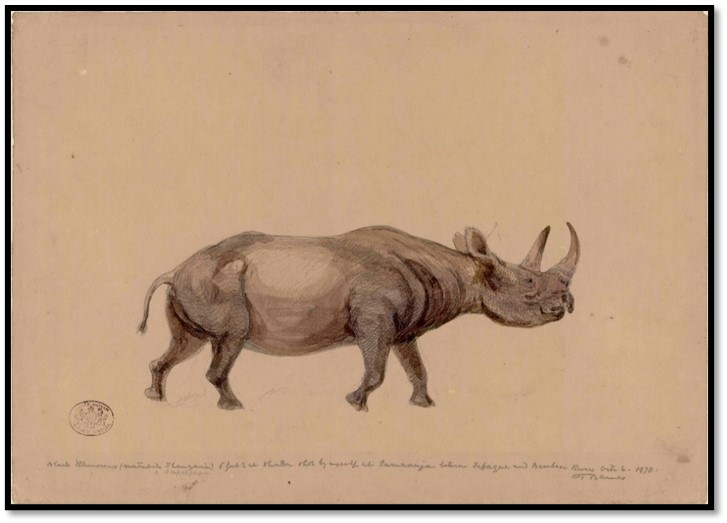
Natural History Museum (London) Baines Collection No. 113: Black rhinoceros 6ft 2 inches at the shoulder shot by Baines between the Sebaque [Sebakwe] and Impembesi [Bembezana] rivers – 6 October 1870
Thursday 6 October 1870: “In a country of waters if we walk two or three hours without finding a chance to drink we become thirsty and my lips were getting parched when we saw three koodoes [kudus] on our left. Inyassi and I crept within 400 yards and my bullet struck just at the feet of one without effect. Inyassi fired and I got another shot at the retreating animals when the men called out Inkhombi! – a rhinoceros. I turned to the right and, sure enough, there was one trotting towards us. Fortunately, there was a thin bush between us which prevented his seeing us and he passed about 100 yards distant on our right. My first shot took him in the ribs, a little more than a foot behind the shoulder and starting forward and loading quickly, I broke his hind leg on the near side below the hock, and the men, throwing down their burdens, immediately ran in upon him, stabbing with their assegais. Of course they dare not go near his head, but they struck one weapon in the rump and left it there. Inyassi outran me and fired and I again passed him and gave the rhinoceros another shot in the shoulder as he wheeled round and round to escape or drive off his persecutors. He was now fairly exhausted and helpless. The men closed in and struck him with assegais in hand. The point of the first one turned and the blade curled up nearly to the shaft, but others had keener edges and being at first driven with force enough to cut the skin, were then thrust deeper and worked with savage zest in the wound, till the blood began to flow from the mouth and nostrils and the poor beast sank choking to the ground…”
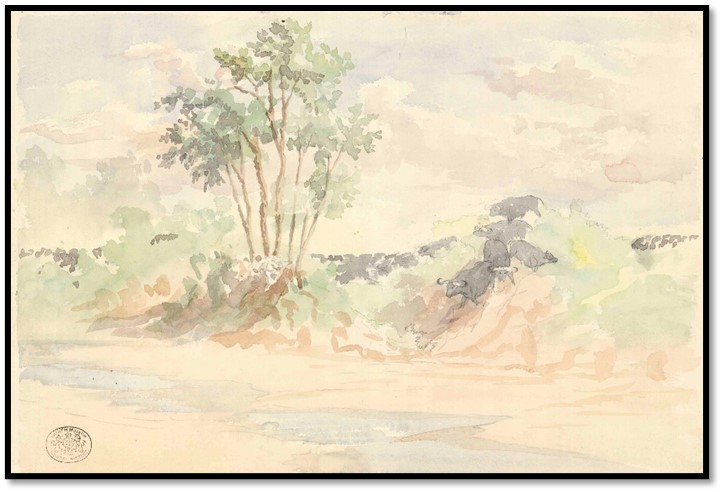
Natural History Museum (London) Baines Collection No. 130: Buffalo on the Sebaque [Sebakwe] – 7 October 1870
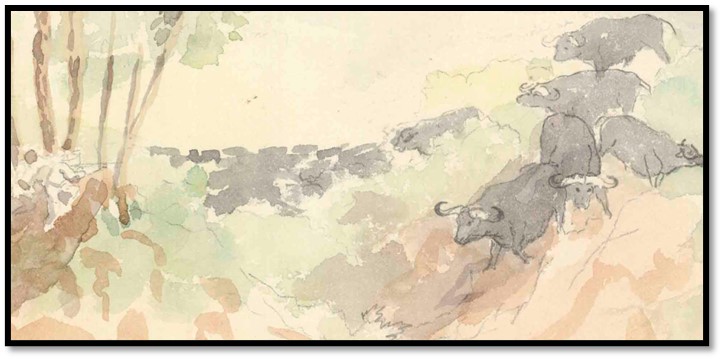
Friday 7 October 1870: “We left the Impembesi [Bembezana] about half past seven and proceeded to Sebaque [Sebakwe] I saw the fresh spoor of buffaloes that had travelled some distance along the road in the early morning and then turned out to the right, or south… At length my henchmen, Golube (or pig) called my attention to a dark object half hidden among the flower foliage of a mopanie [mopane] tree and in another moment I made it out to be a buffalo, the compact and massive form, set low upon its sturdy limbs, the high shoulder, the low head and the malevolent expression imparted to the eyes by the huge masses of horn which shield and overshadow them, leaving no doubt upon that point.
My bullet struck the very centre of the shoulder breaking the bone and as the crippled animal turned back to the shelter of the tree, another came into full view and, thanks to the simplicity of the Wilson breech loader, I was able to treat him to a second bullet and had a third ready to stop him with as he came, slowly at first but gradually gathering speed, towards me. Had he still come on, I should have taken cover of some mopanie trees on my right, but they both broke away past the little grove, giving Jewell a fair chance, which he availed themselves of very creditably, planting his bullet of 12 to the lb[xxiii] just behind my smaller one, the drivers Charley and Mackenzie (British Zulus) also firing with effect…
Leaving Jewell to finish off the crippled but still somewhat dangerous animal, I shouted to the men to give chase to the other and had just come nigh enough for a good shot when Umfundusi fired across me, hitting the beast and causing him to start away so as to leave me only a flanking shot which also took effect. By this time the naked men were beginning to outrun me and calling to them to ‘Keer voor’ or turn him from the front, I ran round and was within perhaps 80 yards when I saw them turn to the left and fire a volley into the long grass and then rush in with brandished assegais, where as I pressed forward pushing aside the tangled herbage, I beheld a mighty bull, apparently the patriarch of the herd, tossing in mortal agony but still capable of making an effort to rise and probably of yet avenging himself on some of us…After a few more groans the eyelids drooped, the breath no longer gurgled through the grey nostrils, the sides collapsed and in the late powerful frame there was now nought of life left save shivering where the limbs slightly quivered.”
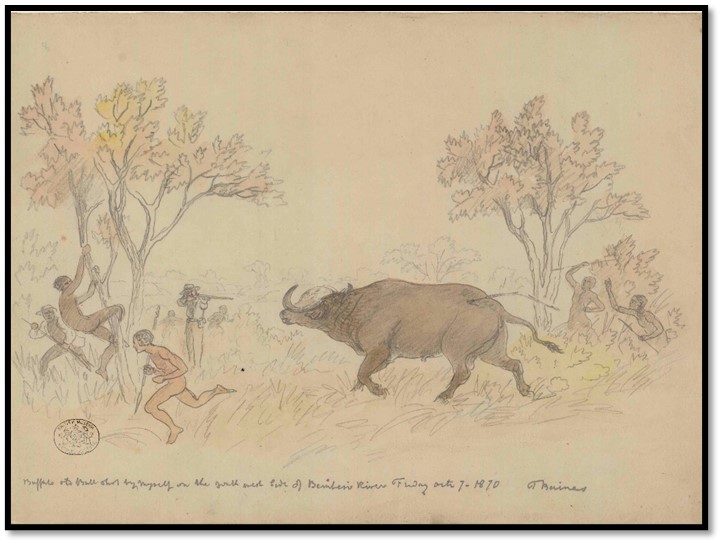
Natural History Museum (London) Baines Collection No. 133: The old buffalo bull shot by Baines south-west of the Sebakwe river - 7 October 1870
The text describing this scene is included above.[xxiv]
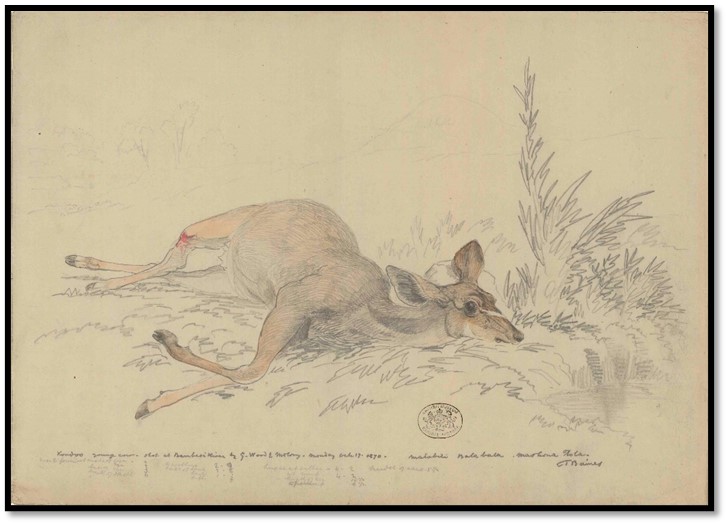
Natural History Museum (London) Baines Collection No. 138: young cow Koodoe [Kudu] shot by George Wood and Thomas Maloney at the Bembezana river – 17 October 1870
Monday 17 October 1870: “last night a report was brought home that two of the oxen were missing, one a poor one named Fontein, the other a good after-ox of Charlie’s span. Jewell sent extra hands to assist the herdsman in searching for them, but as yet they are not found. Between 7 and 8 the cracking of whips was heard and the waggons of Mr Hartley and the other hunters arrived about breakfast time and George Wood coming on horseback from the right, driving before them a koodoe [kudu] doe which they would have brought right into camp, had she not plunged into the pool of the little rivulet and drowned herself. They kindly gave me time to make a sketch and would have given me the carcase itself had I wished it. It was a young cow which apparently had had one calf and was pregnant with a second and her form seemed the very perfection of beauty and gentleness. Her head was finely tapered, the nose small, the eyebrows broad and the large full liquid eye, although its lustre was dimmed by death, seemed not merely to fill the orbit but actually to swell beyond it. The ears were large and mobile and the whole expression of the countenance was gentleness and timidity. The neck was slender, the legs moderately so, the body moderately rounded, and the udder full of milk. The general colour greyish fawn, slightly warmer in tint on the face and legs and somewhat blueish on the neck.”
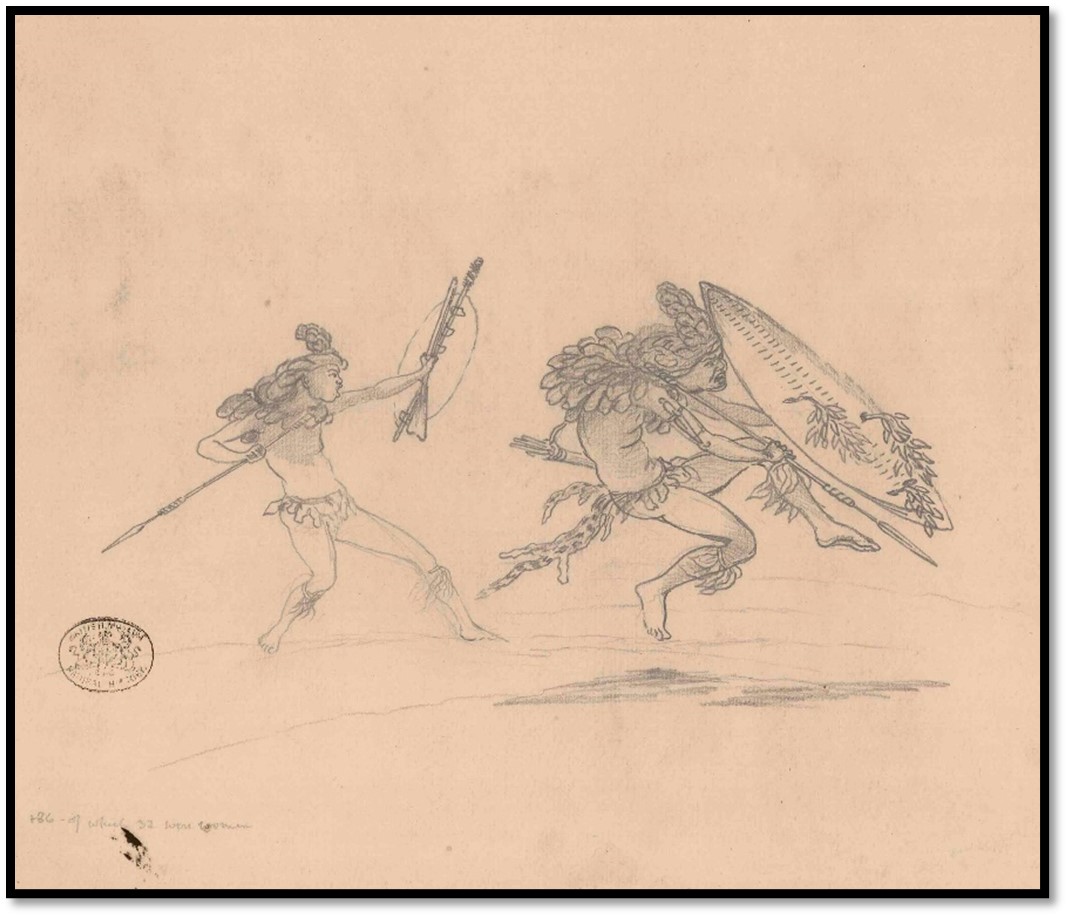 Natural History Museum (London) Baines Collection No. 63: Baines’ note below the sketch ‘186 of which 32 were women.’ 15 November 1870
Natural History Museum (London) Baines Collection No. 63: Baines’ note below the sketch ‘186 of which 32 were women.’ 15 November 1870
15 November 1870: “As the army was expected in, no business could be done, the king telling us, very naturally, that his people would be angry and jealous if he neglected their business to attend to us. About 9 we saw the advanced guard coming over the distant hills and all the morning fresh parties and herds of oxen kept arriving at the halting place outside the town. About noon the army collected and entering the great kraal, the various regiments sending forward a couple of messengers each to announce their arrival and then running in, two abreast, like troops coming on at the double. They turned off in succession to the right and then, facing toward the king, formed a close line, two deep, the shield of each man overlapping the man on his right and the successive regiments, as they came in and joined the line, forming rather more than a semi-circle, dressed with a precision that would have charmed a military eye around the king. They numbered probably 1,200 or 1,400 men and with their large oval shields, some black, some black and white and others red and white according to the colours of their regiments and their large capes of black ostrich feathers and head wreaths and tall plumes of the same, they looked as formidable a body as one could wish to meet...
…The commander-in-chief first came forward and narrated in order the progress of the expedition. They had gone in the direction they were sent, turning out to the right of their course and sweeping the country as they went, killing 186 persons, of whom 84 were women, and capturing very close upon 3,000 cattle. But they had failed to affect a junction with the larger body which followed and with whom they were to have swept round to the left and pillaged the country more to the north, for which the king did not fail to reprimand them. However, after an awkward silence, the petty chiefs were allowed to come forward and boast of their deeds, and then the various men who had distinguished themselves sprang out in turn and running, leaping, crouching behind their shields, charging, retreating and stabbing in the air, gave one decisive stroke for each victim slain and so narrowly, is the accuracy of detail watched that a serious feud has occurred on account of one regiment claiming three slain more than was its due.”
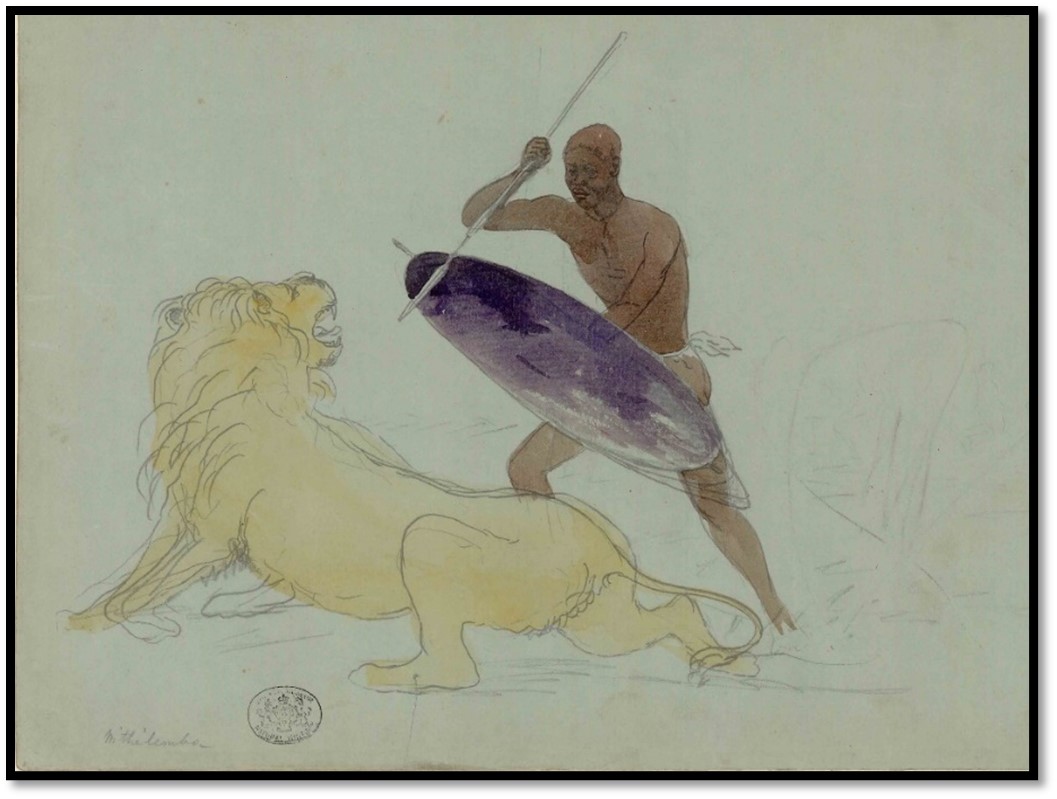
Natural History Museum (London) Baines Collection No. 89: 22 November 1870
Tuesday 22 November 1870: “last night Mr. Carter[xxv] and Spearman,[xxvi] who had gone out with the detachment to kill the lions, returned, having enjoyed a sight, I would have given anything to witness. They had each succeeded in getting a shot at the lion, although without effect. But the Matabele rushed forward and one of them drove his assegai deep in between the ribs. It is a curious motion, this striking of the assegai. It is not, as a rule, raised aloft and struck into the body as a harpoon is into a whale, but after the animal, worried and tormented with feints and false movements, rests for a moment and gathers together his confused ideas, the point of the spear is placed upon the skin and with a slight vibration of the wrist, is guided into the hollow between two ribs. The whole force of the arm is then exerted to drive it home, the thin iron shank allowing it to go in 15 or 20 inches, before it is checked by the shaft. It is then rapidly worked up and down in the vitals, til either the beast falls or the man is obliged to retreat, drawing his spear if he can or leaving it in the wound if he cannot.
On the present occasion, neither was the lion tame nor the man unskilful. The bold fellow dashed up, planted his assegai and drove it home. The lion turned in rage and pain, clawed the little hunting shield that was pushed forward to his face and forced the hunter to his knees. But the brave fellow struck him again and others coming to his assistance, the lion, pierced with a dozen wounds, rolled lifeless on the earth. Another was killed in a similar manner, not very far away and this morning the carcases were brought in, the hunters at first hauling the waggon, as oxen are unruly when they smell a lion.”
References
J.P.R. Wallis (Editor) The Northern Goldfields Diaries of Thomas Baines 1869-1872, Volumes 1-3 Oppenheimer Series No 3, Chatto and Windus, London 1946
Natural History Museum (NHM) London for painting and sketch images (https://www.nhm.ac.uk/)
Notes
[i] Wikipedia
[ii]Losberg is north-east of Potchefstroom that they reached 3 days later on 27 April 1869
[iii] Baines used a Wilson Patent breech loading rifle made in Birmingham by Thomas Wilson that used percussion caps to initiate the firing. Wilson only appears in the directories for a short period but he held 25 British firearms patents registered between 1855 – 1868. His limited time as a firearms manufacturer belies his significant influence on firearms design and development and his patented designs were used by many. His rifles were produced in two calibres 28 Bore (.551) and 56 Bore (.451) and Baines does not say which model he had, but most probably the larger bore.
[iv] Inyassi was the guide appointed by Ncumbata, the amaNdebele regent, to ensure Baines expedition only did what it was authorised to do i.e. explore and prospect for gold, but without mining and no elephant hunting. This was the usual custom with Europeans – Henry Hartley’s guide was Inyoka (snake) and accompanied him to ensure only elephants were hunted.
[v] Sir John Swinburne was leader of the London and Limpopo Mining Company expedition but made himself unpopular with both the amaNdebele and his fellow explorers. He failed to visit and pay respects to Ncumbata, the regent between the death of Mzilikazi and Lobengula and his miner August Griete was allowed by Swinburne to dig two exploratory shafts at Hartley Hill on quartz reefs – this had not been authorised by the amaNdebele. In all these actions he was aided and abetted by Rev Thomas Morgan Thomas who actively meddled in goldfields politics and contrived to get the London and Limpopo Mining Company a monopoly of the Northern Goldfields. Morgan tried also to usurp John Lee’s authority as amaNdebele agent; Lee had been appointed by Mzilikazi. Thomas sent notices to Old Tati that all miners were required to pay him (Thomas) a fee and that the amaNdebele had given him authority over all Europeans in the country. All this was untrue and when Swinburne and Thomas were questioned by Ncumbata and the councillors on their actions they attempted to shift the blame onto Thomas Baines but were by then thoroughly discredited.
[vi] Amakoonda was a Mashona chief who lived approximately 3½ days journey to the north-west and offered to sell the expedition maize, rice and groundnuts. Possibly the Makonde district is named after him.
[vii] Mbira, a traditional music instrument of the Shona people.
[viii] Baines having been brought up in sailing ships was very familiar with using hoists and tackle. many of these techniques are also to be founf in his book co-authored with W.B. Lord: Shifts and Expedients of Camp Life, Travel and Exploration
[ix] Two of the amaNdebele are attempting to lift Old Zwartland with a pole underneath him and one is biting his tail.
[x] Slambo Boloi (Bath of Majesties) was on the Kumalo road where it passed Umzinyati village and crossed the Umghoosi [Umguza] river
[xi] Toosah were presents requested from the travellers.
[xii] William Watson was a cousin of Thomas Baines living in Natal and joined the Baines expedition along with Robert Jewell and C.J. Nelson. He was a good isiZulu speaker and often acted as interpreter and being a blacksmith by profession had useful skills for repairing wagons.
[xiii] Eduard Mohr and Hübner left Germany in late 1868 to report on the new goldfields on the advice of Petermann who also had great influence on Karl Mauch and Paul Jebe. They frequently camped with Baines and Mohr and Baines shared their mutual interest in mapping. Their planned visit to the Victoria Falls was delayed by the succession of Lobengula as king. Hübner left for the diamond fields in January 1870. Mohr finally received permission and accompanied by Cluley and Bokkis in early June 1870 reached the Deka river which they followed to the its confluence with the Zambesi and camped at Baines’ site of Logier Hill. Here Mohr hired guides and porters and walked to the Falls from 15-20 June and returned to Logier Hill by 26 June 1870. On his return he stayed at Old Tati to investigate the goldfields and left South Africa in February 1871. Wrote the book To the Victoria Falls of the Zambesi.
[xiv] Dr Coverley was manager of the Glasgow and Limpopo Company although he hunted in the Zambesi Valley and walked to the Victoria Falls in July 1869 with Thomas Leask. Resident at Old Tati in 1869-70 where he treated Henry Hartley after he was tossed by a rhino and may have travelled to Mashonaland in in the winter of 1870. Left Old Tati in December 1870 with Baines and Hartley wagons.
[xv] Sam Edwards (1827-1922) an old hand who served at different times as hunter, trader, explorer, transport manager, interpreter, guide, mine manager and British agent. He had served as transport manager to the London and Limpopo Mining Company at Tati. In 1881 he tried to get a mineral concession from Lobengula and was given the abandoned Tati concession for an annual £50 rental and stayed here for the next ten years as managing director of the Northern Light Company and served as Lobengula’s ‘immigration officer’ in much the same way as John Lee. Very popular with travellers and good friend of Baines.
[xvi] The Paopisa tree is the Portuguese word for the Sausage tree (Kigelia pinnata) also still found on the banks of the Mupfure river today.
[xvii] Robert Jewell was the expedition secretary of the South African Gold Fields Exploration Company and the expedition photographer. Apart from the photograph taken by Jewell of Willie Hartley’s grave I have not been able to trace any of his photographs.
[xviii] Accidents shattered the spokes of the wagon-wheels or they shrunk and needed replacing – it was a laborious effort of making and fitting new ones in the wilderness, but Baines delighted in hard work and being resourceful.
[xix] the Natal orange (Strychnos spinosa)
[xx] Henry Hartley the famous elephant hunter had first visited Matabeleland in 1859 and became a firm friend of Mzilikazi and in 1865 was given permission to hunt elephant in Mashonaland. In 1866 he guided Karl Mauch to the Northern Goldfields who confirmed the existence of gold from the presence of Mashona diggings. In 1867 Hartley and fellow hunters again hunted in Mashonaland and again in 1868 when they hunted as far as the Ganyana [Hunyani / Manyame] river. In 1869 Hartley and his hunters accompanied the Baines expedition
[xxi] Thomas Maloney was Henry Hartley’s son-in-law and accompanied the annual hunting parties to Mashonaland during the period 1866 - 1870
[xxii] George Wood, his brother Swithin and half-brother Thomas came to Natal in 1865 from Yorkshire. In 1867 they hunted in the Zambesi Valley, the following year they were in the vicinity or present-day Masvingo. In 1869 they hunted around Tati with Byles and McMaster when Firmin was killed by an elephant at the Ramaquabane river. In June 1869 he married Mrs McMaster’s sister, Miss Fraser at Inyati. In 1870 they went into Mashonaland in a very bad fever year. William Hartley died, also McDonald [James O’Donnell] his driver Toris [Pretorius] and another young boy. George Wood lost his young wife, her child and her mother, Mrs Fraser. Mrs McMaster, the sister of Mrs Wood, was the only surviving lady and she had lost her child at Tati earlier in the year. Baines accompanied them north of Hartley Hills and went on to Amakoonda’s village for supplies. On the way out of Mashonaland the Wood party hunted with the Hartley party at the Umniati (Munyati) and at the Sebakwe for elephant.
[xxiii] 12-bore, elephant hunters tended to use large smooth-bore black powder roers, often 6-bore.
[xxiv] In the text under the watercolour of this scene where Baines shoots the old bull buffalo he writes that it occurred south-west of the Bembezana river, but in the text of the diaries he writes they had crossed the Bembezana river and were proceeding to the Sebakwe river; that would make it south-west of the Sebakwe river
[xv] Carter was a trader in Matabeleland – not much known about him
[xvi] Joe Spearman came with his brother George (died 1869) and others as members of the Sydenham party or Durban Pioneer Tati Concessions. After his companions left for the diamond fields Joe remained and in November 1870 was helping to build a wagon shed for Lobengula.
When to visit:
n/a
Fee:
n/a
Category:
Province:
